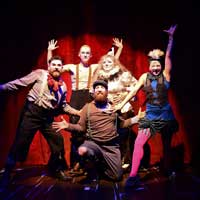
 Recommended ***1/2 “After the fire happened, the mayor of Chicago closed down every theatre in the city. The stages, they were dark and the doors locked, all because of what had happened.” Sound familiar? So opens the video archive performance of “The Ruffians’ Burning Bluebeard” that dates from December 2019. Now available on streaming video through the Porchlight Music Theatre website, the show seems strangely prescient of the current ban on live theatre with the COVID-19 pandemic.
Recommended ***1/2 “After the fire happened, the mayor of Chicago closed down every theatre in the city. The stages, they were dark and the doors locked, all because of what had happened.” Sound familiar? So opens the video archive performance of “The Ruffians’ Burning Bluebeard” that dates from December 2019. Now available on streaming video through the Porchlight Music Theatre website, the show seems strangely prescient of the current ban on live theatre with the COVID-19 pandemic.
Last year at this time, I went to the Ruth Page Center for the Arts, in Chicago, to review “Burning Bluebeard.” This year, I was asked to review the exact same performance… and I really mean that. Towards the beginning of the video stream, I can see the back of my head in the audience, seated next to two women wearing headscarves immediately to my left. So the question I had to ask myself is this: What might be different between the show I watched in person versus today’s recorded session?
Of course, the medium is different: What we see on a large stage looks somewhat different on our computer screen. We don’t see the splendid set design nearly as well. We also don’t hear the gorgeous sound design. In the video, the volume and sound quality are uneven, but this review is not intended to pick fault: the recording for the archive was never meant to be released to the general public. But we live in unusual times.
As for those who may have read my previous review from a year ago, you’ll notice that I bumped it up to three-and-a-half stars. The change has to do with perspective, and mine has shifted radically as a result of the 2020 pandemic. Last year, times were comparatively merry and bright, whereas this year’s holiday season is more akin to the underlying theme of “Burning Bluebeard” when one of the characters says, “We’re all going to die!” Since March and the onset of COVID, all of us have been constantly confronted by thoughts of our own mortality, and this show is exactly about that: the seeming randomness of death and dying. The performers capture feelings of the loss of family members and friends and even complete strangers, and the depth of sadness when children’s lives are cut short.
The script for “Burning Bluebeard” was written by playwright Jay Torrence, based on actual accounts of the Iroquois Theatre fire that took place in downtown Chicago during Christmas week of 1903. At that time, an overflow crowd was in attendance at a Wednesday matinee performance of “Mr. Blue Beard.” The family-friendly burlesque show was a takeoff on the original “Bluebeard”, a fairy tale about a monstrous human being—a serial killer and wife-murderer—who told his present wife never to enter a particular room in their house. But the comparatively mediocre script came to a much more dramatic end during the second act when parents and children in the audience died in a tragic fire: either consumed by flames or smoke asphyxiation or killed by a stampede in a rush to the blocked-off and unmarked exits.
The beginning of the first act of “Burning Bluebeard” is fantastic. Anthony Courser plays the actor Henry Gilfoil and sets up the tale. In addition to Courser, the entire cast does a great job with their vivid eyewitness accounts of that fateful day from the vantage point of the actors and stage crew. Performers include Pam Chermansky (Fancy Clown), Jay Torrence (stage manager Robert Murray), Leah Urzendowski (aerialist Nellie Reed), and Ryan Walters (comedian Eddie Foy), with Crosby Sandoval as the mute Faerie Queen. As we listen to their characters’ biographies, we in the audience are horrified by what we see and hear. We can’t help but notice how so many of those who lived through this terrible tragedy have suffered from survivors’ guilt. The combination of great acting, dancing, and jesting makes the performance memorable. The second half of the first act drags in spots when it becomes difficult to follow all the jokes and the audience’s reaction to them. And yes, there was this one fellow whose laugh was so loud that it could be heard far too distinctly in the recording. The second act, alluded to throughout the first, is fabulous, corresponding with the time when the electrical fire took place. Just note that there is no intermission in the video or any indication of a break between the first and second acts.
The superior choreography by Urzendowski and Ariel Etana Triunfo are particularly moving, adding volumes of terror to the script. Costume design by Bill Morey, USA, is appropriately period-specific. Director Halena Kays can boast of making excellent use of the stage and stagecraft. Especially wonderous is the sudden gust of winter air which eerily lights up the dark scene towards the end of the show. The foreboding music seems to work better when watching the video than the live performance. The special effects seem to be more realistic in the video, although we miss some of the serendipitous interaction when the players hand lanterns to audience members to represent glowing embers. Bek Lambrecht, the technical director, and Rachel West, the main electrician, need to be called out for special recognition for how the set was wired and how they got the separate lanterns to brighten and dim remotely. Additional credits must go to Marty Higgenbotham and the Stage Channel for creating the video production, together with Austin Packard, the video editor.
People then and now are fascinated by how a faulty light and shoddy wiring could have triggered the cataclysm, just as we are similarly intrigued today by theories of what might have caused the spread of the COVID virus. But while flames are tangible and their heat and smoke felt, the virus is unseen: It operates by stealth and kills and ravages in mysterious ways. The Iroquois Theatre fire, on December 30, 1903, killed 602 people. At the time, it was the deadliest theatre fire and the deadliest single-building fire in U.S. history. The pandemic of 2020 has left 270,000 dead in the U.S. as of this writing. I state this not to weigh deaths comparatively or to trivialize what had happened to all those souls who perished in the conflagration and died a most horrible death. Yet a necessary parallel must be drawn: Ridding ourselves of COVID is like trying to put out a fire that continually spreads.
Back in the day, the glitzy and glamorous Iroquois Theatre was considered one of the most modern structures for its time. It was said then that “few theatres in America can rival its architectural perfections”: this despite the fact that there were no fire alarms, sprinklers, telephones, or water connections. Everybody was confident that nothing bad could possibly happen at that venue, because everything was so modern, as if that were an inoculation from harm. To put it succinctly, a fire of such horrific proportions was not supposed to happen there and then. Similarly, a disaster like the COVID crisis is not supposed to happen today. It simply doesn’t fit the narrative that so many people want to believe in.
When the fire first broke out during the matinee, it became evident shortly thereafter that the Faerie Queen could not fix this, inasmuch as the actors would have wished her to do so. Yes, good theatre makes us all believe in magic, but a good tech crew must believe in science. The aftermath of the fire resulted in the enactment of building codes to make sure that nothing like this would ever occur again. However, all this was too late to save the people and the building on that fateful day. At the end of Act II, the audience is offered an apology, “Sorry we couldn’t give you the show you wanted and make you happy.” The same could easily be said about the current pandemic: 2020 is not the year that anybody wanted or expected, but we still have to live with it.
“The Ruffians’ Burning Bluebeard: Chicago’s Holiday Legend” is currently available for video streaming through Sunday, January 3, 2021.
$15 – $50 tickets are available at PorchlightMusicTheatre.org.
Links are available for viewing 72 hours after purchase. Running time is 105 minutes, plus the after-talk with playwright Jay Torrence, director Halena Kays, and Porchlight’s artistic director Michael Weber.
This streamed performance was filmed during the 2019 run at The Ruth Page Center for the Arts, 1016 N. Dearborn Street, Chicago.
For more information, go to PorchlightMusicTheatre.org or GoRuffians.org.
Editor Note: At first Julia had said “pass” I saw it before, but after viewing, realized that even though this was a previous production, you get more each time you view. To see what others are saying, visit www.theatreinchicago.com, go to Review Round-Up and click at “The Ruffians’ Burning Buebeard”.






More Stories
“Prayer for the French Republic” reviewed by Julia W. Rath ( and another by Paul Lisnek)
“Obliteration” reviewed by Mark Reinecke
” A Jukebox for the Algonquin”